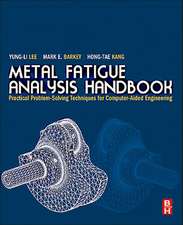Atomistic Modeling of Materials Failure
Autor Markus J. Buehleren Limba Engleză Hardback – 18 aug 2008
| Toate formatele și edițiile | Preț | Express |
|---|---|---|
| Paperback (1) | 956.99 lei 6-8 săpt. | |
| Springer Us – 31 mar 2010 | 956.99 lei 6-8 săpt. | |
| Hardback (1) | 961.55 lei 6-8 săpt. | |
| Springer Us – 18 aug 2008 | 961.55 lei 6-8 săpt. |
Preț: 961.55 lei
Preț vechi: 1172.62 lei
-18% Nou
Puncte Express: 1442
Preț estimativ în valută:
184.02€ • 191.41$ • 151.92£
184.02€ • 191.41$ • 151.92£
Carte tipărită la comandă
Livrare economică 14-28 aprilie
Preluare comenzi: 021 569.72.76
Specificații
ISBN-13: 9780387764252
ISBN-10: 0387764259
Pagini: 488
Ilustrații: LXVIII, 492 p. 331 illus.
Dimensiuni: 155 x 235 x 30 mm
Greutate: 0.91 kg
Ediția:2008
Editura: Springer Us
Colecția Springer
Locul publicării:New York, NY, United States
ISBN-10: 0387764259
Pagini: 488
Ilustrații: LXVIII, 492 p. 331 illus.
Dimensiuni: 155 x 235 x 30 mm
Greutate: 0.91 kg
Ediția:2008
Editura: Springer Us
Colecția Springer
Locul publicării:New York, NY, United States
Public țintă
ResearchDescriere
Atomistic Modeling of Materials Failure is an introduction to molecular and atomistic modeling techniques applied to solid fracture and deformation. Focusing on a variety of brittle, ductile, geometrically confined and biological materials, this detailed overview includes computational methods at the atomic scale, and describes how these techniques can be used to model the dynamics of cracks and other deformation mechanisms.
A full description of molecular dynamics (MD) as a numerical modeling tool covers the use of classical interatomic potentials and implementation of large-scale massively parallelized computing facilities in addition to the general philosophies of model building, simulation, interpretation and analysis of results. Readers will find an analytical discussion of the numerical techniques along with a review of required mathematical and physics fundamentals. Example applications for specific materials (such as silicon, copper, fibrous proteins) are provided as case studies for each of the techniques, areas and problems discussed.
Providing an extensive review of multi-scale modeling techniques that successfully link atomistic and continuum mechanical methods, Atomistic Modeling of Materials Failure is a valuable reference for engineers, materials scientists, and researchers in academia and industry.
A full description of molecular dynamics (MD) as a numerical modeling tool covers the use of classical interatomic potentials and implementation of large-scale massively parallelized computing facilities in addition to the general philosophies of model building, simulation, interpretation and analysis of results. Readers will find an analytical discussion of the numerical techniques along with a review of required mathematical and physics fundamentals. Example applications for specific materials (such as silicon, copper, fibrous proteins) are provided as case studies for each of the techniques, areas and problems discussed.
Providing an extensive review of multi-scale modeling techniques that successfully link atomistic and continuum mechanical methods, Atomistic Modeling of Materials Failure is a valuable reference for engineers, materials scientists, and researchers in academia and industry.
Cuprins
Basics of Atomistic, Continuum and Multiscale Methods.- Basic Atomistic Modeling.- Basic Continuum Mechanics.- Atomistic Elasticity: Linking Atoms and Continuum.- Multiscale Modeling and Simulation Methods.- Material Deformation and Failure.- Deformation and Dynamical Failure of Brittle Materials.- Deformation and Fracture of Ductile Materials.- Deformation and Fracture Mechanics of Geometrically Confined Materials.
Textul de pe ultima copertă
Atomistic Modeling of Materials Failure is an introduction to molecular and atomistic modeling techniques applied to solid deformation and fracture. Focusing on a variety of brittle, ductile and geometrically confined materials, this detailed overview includes computational methods at the atomic scale, and describes how these techniques can be used to model the dynamics of cracks, dislocations and other deformation mechanisms.
A full description of molecular dynamics (MD) as a numerical modeling tool covers the use of classical interatomic potentials and implementation of large-scale massively parallelized computing facilities in addition to the general philosophies of model building, simulation, interpretation and analysis of results. Readers will find an analytical discussion of the numerical techniques along with a review of required mathematical and physics fundamentals. Example applications for specific materials (such as silicon, copper) are provided as case studies for each of the techniques, areas and problems discussed.
Providing an extensive review of multi-scale modeling techniques that successfully link atomistic and continuum mechanical methods, Atomistic Modeling of Materials Failure is a valuable reference for engineers, materials scientists, and researchers in academia and industry.
A full description of molecular dynamics (MD) as a numerical modeling tool covers the use of classical interatomic potentials and implementation of large-scale massively parallelized computing facilities in addition to the general philosophies of model building, simulation, interpretation and analysis of results. Readers will find an analytical discussion of the numerical techniques along with a review of required mathematical and physics fundamentals. Example applications for specific materials (such as silicon, copper) are provided as case studies for each of the techniques, areas and problems discussed.
Providing an extensive review of multi-scale modeling techniques that successfully link atomistic and continuum mechanical methods, Atomistic Modeling of Materials Failure is a valuable reference for engineers, materials scientists, and researchers in academia and industry.
Caracteristici
Makes new molecular modeling techniques available to a wider community of engineers and scientists
Discusses large-scale molecular dynamics modeling applied to fracture and deformation
Covers recent advances in the understanding of atomic-scale mechanisms of brittle fracture and materials deformation
Provides links between classical continuum theories and physics and chemistry related approaches
Discusses large-scale molecular dynamics modeling applied to fracture and deformation
Covers recent advances in the understanding of atomic-scale mechanisms of brittle fracture and materials deformation
Provides links between classical continuum theories and physics and chemistry related approaches








